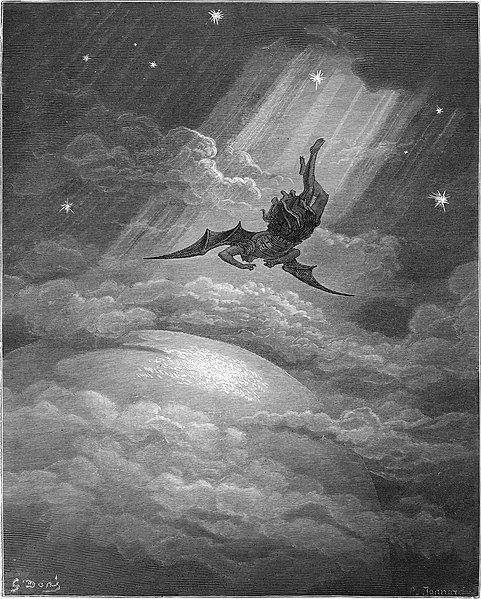Milton’s Satan Heads to Earth
In the last part of our extensive series “Illustrious Ideas and Illustrations: The Imagery of Gustav Doré,” we saw Satan confront his children, Sin and Death, at the gates of Hell as told by John Milton in his epic poem “Paradise Lost.” Sin and Death agree to let Satan pass out of the gates of Hell, and Satan continues his journey to find God’s new creation: Earth.
God, Satan, and the Future of Humans
As Milton’s “Paradise Lost” continues, God watches Satan from Heaven and makes the point that He knows Satan will tempt human beings. He explains the immensity of Satan’s evil by suggesting that Satan came to hate Him from within himself. The humans that Satan will tempt, however, should be shown grace because they do not hate God from within but will be tempted to resist God because of Satan’s efforts.
God asks the other beings in Heaven: Who will sacrifice themselves for the eternal life of humans? Only Jesus, God’s son, comes forth. God praises Jesus’s love and compassion.

Satan’s Flight to Earth
Meanwhile, Satan is flying aimlessly looking for Earth until he finds one of the seven archangels, Uriel, thinking deeply about something out in the distance. He knows Uriel will condemn him if he approaches him in his true form, so Satan decides to change forms to deceive Uriel.
“Glad was the Spirit impure; as now in hope
To find who might direct his wand’ring flight
To Paradise the happy seat of man,
His journey’s end and our beginning woe.
But first he casts to change his proper shape …
And now a stripling Cherub he appears.” (Book III, 631-634, 636).
Disguised as a cherub, Satan approaches Uriel and asks him where he can find Earth, so he can praise God for his new creation. Uriel tells the deceitful one how God created Earth and where Earth is located:
“I saw when at his word the formless mass,
This world’s material mould, came to a heap:
Confusion heard his voice, and wild uproar
Stood ruled, stood vast infinitude confined;
Till at his second bidding darkness fled,
Light shone, and order from disorder sprung …
Look downward on that globe whose hither side
With light from hence, though but reflected, shines;
That place is earth the seat of man …” (Book III 708-713, 722-724).
Doré’s Use of Contrast
Doré’s illustration shows the dark figure of Satan heading toward Earth, which is illuminated by a light shining from the heavens. This light reiterates the point that, despite Satan’s efforts, the Earth and its inhabitants are created by God, and their nature is divine.
Clouds cover the earth except in the area where the light of heaven shines. Maybe the clouds are symbolic for confusion and chaos. Does this suggest that heaven is responsible for clarifying confusion and ordering chaos? Milton does have Uriel say that God’s voice dismantled confusion with rules, and He ordered disorder.
We can associate confusion and chaos with the opposite of truth, since we can presume that, by its definition, truth is clear and ordered. If this is the case, then Doré’s depiction is more nuanced than it may initially seem. What Doré may be illustrating is the contrast between truth and deception.
Milton tells of Satan’s deceptive ways as Satan turns into a cherub to trick Uriel. Unlike the truth, which in its purest form is always true, Satan will change not only appearances multiple times (as we will see later), but what he represents shifts as well. As we move through the series, for example, Satan’s nature seems to change from one evil to the next. First, it was pride, then power, and vanity. Now, his nature is deceptive.
Thus, Doré’s depiction of a dark Satan may align with Satan’s nature as something that seeks to obscure the truth. In other words, Satan represents the opposite of truth. Milton makes it clear that even the righteous among us can be deceived by lies. Uriel, an archangel within view of God’s throne, was deceived by Satan, for according to Milton,
“neither man nor angel can discern
Hypocrisy, the only evil that walks
Invisible, except to God alone.” (Book III 682-684)
Satan is successful because he is a master of hypocrisy: He can pretend to be righteous in order to destroy what is righteous.
Milton also clearly contrasts what he believes to be the characteristic difference between God and Satan. God is the truth of self-sacrifice for the sake of love; and Satan is the falseness that seeks to destroy truth for the sake of pride.
In a world filled with deception and lies, where the immoral masquerades as righteous, how might we discern what is really true and bound in compassionate love?
Gustav Doré was a prolific illustrator of the 19th century. He created images for some of the greatest classical literature of the Western world, including “The Bible,” “Paradise Lost,” and “The Divine Comedy.” In this series, we will take a deep dive into the thoughts that inspired Doré and the imagery those thoughts provoked. For the first article in the series, visit “Illustrious Ideas and Illustrations: The Imagery of Gustav Doré.”





